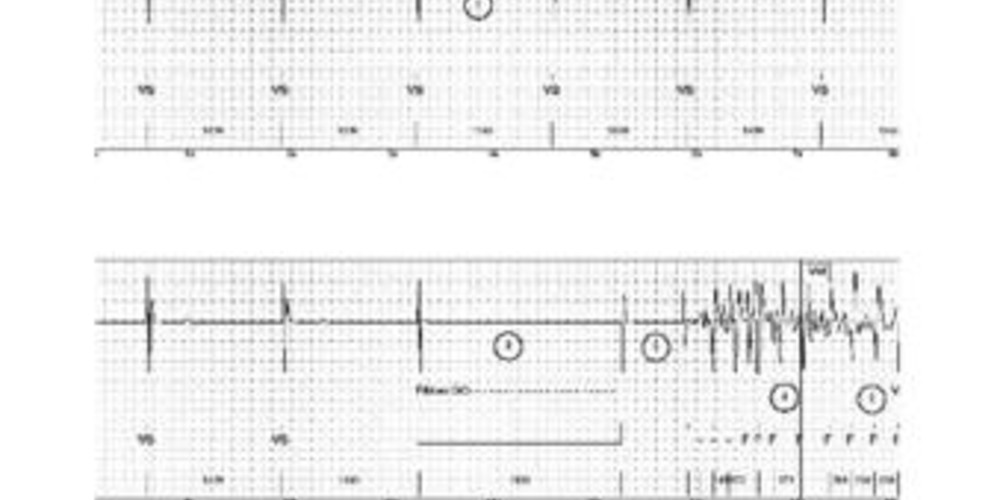Induction of ventricular fibrillation in presence of high defibrillation threshold
A 47-year-old man presenting with ischemic cardiomyopathy, old anterior myocardial infarction, a 35% LVEF and an episode of sustained VT, was placed on a regimen of amiodarone and underwent implantation of an Atlas single chamber ICD and VF induction procedure.
Main device programming (during the induction procedure)
- Single VF zone for rates >187 bpm
- 8 cycles in the VF zone were needed for the diagnosis, 6 cycles for re-detections
- Sensitivity programmed at 1 mV
- First shock at 17.5 J, second shock at 34 J

1: Spontaneous rhythm (VS);
2: Delivery of DC for 2 sec;
3: 600-ms post-induction blanking period;
4: VVI episode pacing mode after 4 F cycles;
5: Detection of the episode at the beginning of the capacitors charge;
6: Delivery of 17.5-V shock after confirmation at the end of the charge; 1-sec post-shock blanking period;
7: Unsuccessful shock and persistence of ventricular arrhythmia; redetection of VF after 6 F cycles and re-charge of the capacitors;
8: End of charge;
9: Confirmation of the arrhythmia (>6 cycles in the VF zone since the onset of the charge); no shock delivered on the first cycle following the end of the charge;
10: Second, 34-J shock delivered on the second cycle (short cycle in the VF zone);
11: Successful shock and return to sinus rhythm after 5 consecutive cycles classified in the sinus zone.






Approximately 30% of ICD recipients die suddenly, and some of these as the result of unsuccessful defibrillation. The confirmations of successful defibrillation and of a sufficient safety margin are endpoints of major importance when a ventricular tachyarrhythmia is induced at the end of an ICD implantation procedure. We must, however, keep in mind that a successful defibrillation during that procedure is not a guarantee of a stable DFT during follow-up, particularly when a pharmaceutical regimen is modified. The DFT is the lowest energy that terminates VF. In contrast to the pacing threshold, the DFT is not an absolute value above which defibrillation is predictably successful, and below which invariably unsuccessful. Measurements of the DFT only estimate the likelihood of successful defibrillation. By repeating the test, the likelihood of success of a shock of fixed energy increases. For instance, after the successful delivery of 5 shocks of the same energy, the likelihood reaches 97.5 %, which, however, seems hardly achievable in clinical practice.
Various options were available for this patient. One could, for example, have changed the waveform and polarity of the shock. In Abbott ICDs, the duration of each of the 2 phases of a biphasic shock can be programmed separately. Optimizing these durations as a function of the shock impedance might lower the DFT, particularly when it is high. In the nominal configuration, the RV coil is the anode, which can be reversed without guarantee of greater efficacy. This patient’s single coil defibrillation lead was initially placed on the RV floor, with the distal coil straddling the tricuspid valve. This suboptimal lead position might explain, at least partially, the high DFT, as the electrical field of the shock did not completely encompass the myocardial mass. With the repositioning of the lead in the high septum, sensing was satisfactory, and the successful defibrillation of 2 consecutive episodes of induced VF with 25 J shocks offered a sufficient safety margin. It is also noteworthy that the patient was placed on regimen of amiodarone, which raises the DFT. Its withdrawal might lower the threshold, though probably expose the patient to a higher risk of ventricular tachyarrhythmias.